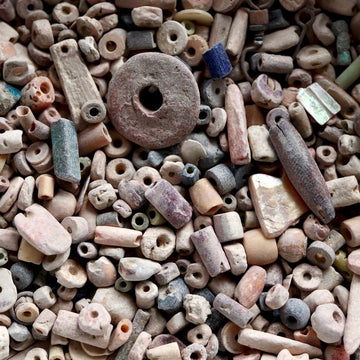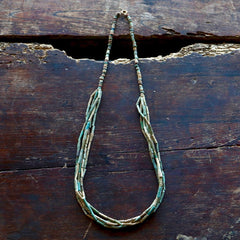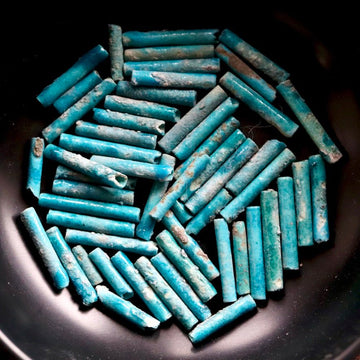A Brief History of Mummy Beads
Mummy beads have been discovered in countless Egyptian tombs, from the grand pyramids to the humblest burial sites. Their use can be traced back to the Predynastic period (c. 6000–3150 BCE) and continued through various dynasties, extending to the Ptolemaic and Roman eras. These beads were made from a variety of materials, including glass, faience, pottery, and precious gemstones.

Composed of a variety of shapes and sizes, Large Earthtone Mummy Beads were once ornately strung around the deceased to help chauffeur them into the afterlife. They often litter the floor of tombs discovered in modern times, and are collected using rudimentary tools such as a broom.
Symbolism and Beliefs
The use of beads in ancient Egyptian burial rituals was not merely for decoration. Each bead held profound symbolic significance. It was believed that these beads had protective qualities that would safeguard the deceased in the afterlife. The intricate patterns and vibrant colors on the beads were thought to invoke various deities, ensuring a smooth journey into the next world.
Manufacturing Techniques
The craftsmanship of these beads was truly exceptional. Ancient Egyptian artisans employed a range of techniques to create these intricate pieces of art. Glass beads, for example, were crafted by winding molten glass around a core, creating delicate patterns and vibrant colors. Faience beads were made from a mixture of ground quartz or sand, soda, and various coloring agents. The mixture was shaped into beads and then fired, resulting in beautiful blue and green hues.
Different Types of Beads

A modern accessory composed of thousands of year old faience, the Queen Hatshepsut Necklace is a luxurious repurposing of these artifacts for modern Egyptophiles
Faience Mummy Beads
Faience mummy beads hold a special place in the realm of ancient Egyptian artifacts. These beads, made from a combination of ground quartz or sand, soda, and various coloring agents, were not just decorative; they were deeply symbolic. The vibrant blue, green and earthtone hues of faience beads were associated with the life-giving Nile River and the rebirth that the ancient Egyptians believed would occur in the afterlife. Faience beads were meticulously crafted, often featuring intricate patterns and designs. Their exquisite craftsmanship and spiritual significance make faience mummy beads a remarkable testament to the artistry and religious beliefs of ancient Egypt.
Amuletic Beads
These beads featured amuletic symbols such as the Eye of Horus, the ankh, and the scarab beetle, all believed to protect and guide the deceased in the afterlife.
Funerary Collar Beads
Elaborate funerary collars adorned with beads were placed around the necks of mummies. These collars were designed to provide protection and to honor the deceased.
Gemstone Mummy Beads
Some wealthy individuals had beads made from precious gemstones like lapis lazuli, carnelian, and turquoise. These gemstone beads showcased the wealth and status of the deceased.

Tubular turquoise mummy beads are some of the most attractive faience styles, often used to accessorize modern jewelry
Rediscovery and Conservation
Many of these mummy beads, after thousands of years, have become brittle and fragile. The strings that once held them together have often deteriorated entirely. Archaeologists and conservators today face the delicate task of restoring and preserving these artifacts. Advanced techniques like micro-CT scanning and digital reconstruction help researchers understand the bead's structure and the way they were strung together in intricate patterns.
Purchasing Mummy Beads
You can find a collection of mummy beads and mummy bead jewelry in our store at the Museum of Jewelry. Collected in Egypt in the 1960s by Shashi and the late designer Laurel Burch - our mummy beads were originally acquired for use in her Laurel Inc line. They have been authenticated by Sue McGovern of Sands of Time Antiques. Though many sellers purport to offer mummy beads and associated jewelry for sale, export of antiquities from Egypt is a lot more closely regulated today. Minimally you want to make sure to understand the provenance and authenticity before purchasing.
Conclusion
Ancient Egyptian mummy beads provide a captivating glimpse into the rich and complex world of this ancient civilization. These small, seemingly insignificant artifacts were anything but; they played a vital role in the religious and cultural practices of the time, providing protection and guidance for the deceased in their journey to the afterlife. The craftsmanship and symbolism embodied in these beads continue to fascinate and inspire researchers, allowing us to connect with the distant past and appreciate the artistry and spirituality of ancient Egypt. As we continue to uncover and study these remarkable beads, we unlock new chapters in the enduring story of this extraordinary civilization.